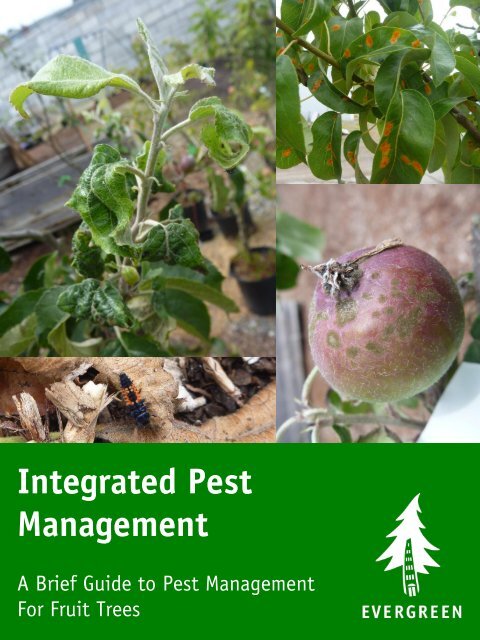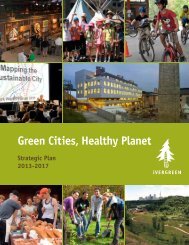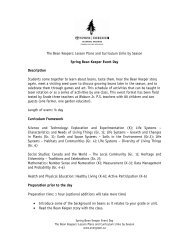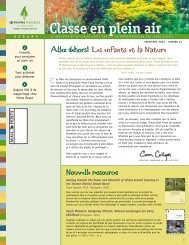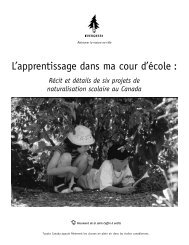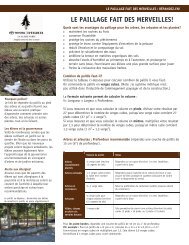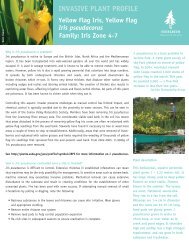Integrated Pest Management - Evergreen
Integrated Pest Management - Evergreen
Integrated Pest Management - Evergreen
Create successful ePaper yourself
Turn your PDF publications into a flip-book with our unique Google optimized e-Paper software.
<strong>Integrated</strong> <strong>Pest</strong><br />
<strong>Management</strong><br />
A Brief Guide to <strong>Pest</strong> <strong>Management</strong><br />
For Fruit Trees<br />
1
Introduction<br />
This report is based on a workshop held July 18, 2012 covering the<br />
basics of <strong>Integrated</strong> <strong>Pest</strong> <strong>Management</strong>. This is the third in a series of<br />
learning modules covering the basics of fruit tree growing in the<br />
Pacific Northwest. The workshops were hosted by <strong>Evergreen</strong> in<br />
Vancouver, BC; the hands on portions of the workshops are carried out<br />
in <strong>Evergreen</strong>’s mobile urban orchard which consists of 60 dwarf apple<br />
trees.<br />
This workshop was facilitated by Dr. Kent Mullinix, a pomologist who<br />
has worked with fruit trees for the past 35 years. He attended the<br />
University of Missouri where he earned a B.Sc. in Agriculture, M.Sc. in<br />
Horticulture (specializing in Pomology) and Ph.D. in Agriculture<br />
Education (curriculum and program development, crop sciences and<br />
soil conservation). He also earned a Ph.D. from the University of<br />
British Columbia in Plant Science (specializing in integrated pest<br />
management). He is a Professional Agrologist with the British<br />
Columbia Institute of Agrologists and currently works as the Director of<br />
Sustainable Agriculture and Food Security at the Institute for<br />
Sustainable Horticulture, Kwantlen Polytechnic University.<br />
These workshops and learning modules are generously supported by the<br />
Organic Sector Development Program, Vancity, the Sitka Foundation, and<br />
the Gencon Foundation.
Overview<br />
This workshop reviewed different pest management approaches and offered some<br />
solutions and options to dealing with the most common pest issues in fruit tree<br />
production. The information shared here focuses on ‘soft’ and organic methods,<br />
primarily for small scale or home growing.<br />
<strong>Integrated</strong> <strong>Pest</strong> <strong>Management</strong> (IPM) is a knowledge intensive,<br />
ecologically based decision making process that uses a variety<br />
of management tools and methodologies to suppress pest<br />
populations to acceptable levels but relies primarily on natural<br />
mortality factors.<br />
IPM approaches don’t necessarily eliminate pests but rather suppress them, and<br />
this wording is very important! Ideally, farming techniques create an<br />
environment that is not conducive to pests or disease in the first place, and can<br />
keep pest populations in balance naturally. IPM focuses strongly on supporting<br />
natural mortality factors (e.g. pests natural enemies). It requires a great deal of<br />
sampling, monitoring, and decision making to be effective.<br />
IPM can work for all types of pests from insects and mites, to fungi, bacteria,<br />
weeds and vertebrates! This guide overviews a number of control methods– we<br />
recommend doing further research on the pests you are dealing with, and on<br />
the methods and products you would like to use. Remember that knowledge is<br />
your first line of defense – the more you know about pest biology, their natural<br />
history, and the damage they cause, the more you can do to effectively control<br />
them.<br />
3
<strong>Pest</strong>icides<br />
Why is our reliance on pesticides a problem<br />
The answer might be obvious to some. However, pesticides continue to<br />
be the primary pest management tool in commercial agriculture. There<br />
are four main issues with pesticide reliance: resistance, resurgence,<br />
induced pests and environmental damage.<br />
Resistance: Most pesticides are not<br />
100% lethal. Up to 2% of the target<br />
insect population may have natural<br />
resistance. As the survivors reproduce,<br />
the genetic resistance to the pesticide<br />
increases. Dosage of the pesticide needs<br />
to be increased, creating a detrimental<br />
cycle.<br />
Resurgence: <strong>Pest</strong>icides will kill 98% of<br />
the pests and 99.5% of the enemy. With<br />
fewer remaining natural enemies the<br />
surviving pest population will boom!<br />
DID YOU KNOW: Every cell of<br />
Monsanto’s genetically<br />
engineered corn and cotton<br />
manufactures its own<br />
insecticide. Five years ago<br />
Monsanto claimed this was<br />
the end of having to use<br />
insecticides externally. But<br />
within only 5 years resistant<br />
insects have emerged!<br />
Induced <strong>Pest</strong>s: There are natural controls<br />
to any pest population. If you destroy<br />
the predators of common and mild pests,<br />
you can create infestations of pests that<br />
wouldn’t have been a problem otherwise.<br />
Environmental damage: DDT, dioxin etc.<br />
remain in the environment and continue<br />
to harm mammals, fish and humans long<br />
after they are used.<br />
4
IPM Approach<br />
The IPM approach<br />
Image: IPM Institute of North America Inc.<br />
#1: Monitor pests<br />
and beneficial<br />
species. Sampling<br />
and monitoring<br />
are critical to<br />
IPM<br />
#2: Estimate population<br />
densities, determine<br />
distribution, assess<br />
damage potential. Do this<br />
by sampling through:<br />
traps, sweep nets, visual<br />
examination, pheromone<br />
traps<br />
#3: Decide on<br />
treatment, based<br />
on action<br />
threshold.<br />
Threshold<br />
determined by<br />
experience and<br />
educated guessing<br />
#4: Keep<br />
records and<br />
evaluate<br />
effectiveness<br />
of<br />
treatments<br />
5
Classification<br />
Key, Secondary, Occasional <strong>Pest</strong>s<br />
Key <strong>Pest</strong>s: Most significant and cause the most damage on a continued basis.<br />
Many are exotic species - they have been imported and have no natural enemies.<br />
Examples of these pests include:<br />
Apple: Scab, codling moth, apple maggot<br />
Cherry: Cherry fruit fly<br />
Pear: Psylla<br />
Secondary <strong>Pest</strong>s: A pest that is not a problem under normal conditions because it<br />
is controlled by a natural enemy. It becomes a problem when the natural system<br />
is altered by pesticide use – the natural enemy is killed off while the pest<br />
demonstrates a natural resistance to the pesticide.<br />
Occasional <strong>Pest</strong>s: <strong>Pest</strong>s that exceed acceptable levels only occasionally, usually<br />
due to environmental influences or human activities.<br />
Direct and Indirect <strong>Pest</strong>s<br />
Direct pests: Eat and/or damage the fruit.<br />
E.g.: Apple Maggot, Codling Moth, Birds<br />
Indirect pests: Feed on foliage or the tree itself, damaging the crop indirectly by<br />
harming the photosynthetic capacity of the tree.<br />
E.g.: Anthracnose, Voles (who eat the root system away)<br />
6
Phenology Models<br />
Phenology Models<br />
Arthropods, microorganisms and fruit trees are all ectothermic; their metabolism, and<br />
development, are regulated by the amount of ambient heat they are exposed to.<br />
For example, codling moth eggs will not hatch until they accumulate a specific amount<br />
of ambient heat.<br />
You can calculate how quickly specific pests (insects, fungi) will develop based on<br />
heat unit accumulation around your tree. The ‘phenology models’ illustrated below<br />
predict development which enables more accurate sampling and treatment of pests.<br />
Images: Orchard <strong>Pest</strong> <strong>Management</strong> Online, Washington State Fruit Commission<br />
7
IPM Strategies<br />
Cultural Controls<br />
These are simple management practices to<br />
make an ecosystem less friendly to pests:<br />
• Strategic plant selection for resistance to<br />
common diseases to your area. See<br />
examples at right.<br />
• Planting sacrificial trees. For example, a<br />
golden delicious apple tree attracts more<br />
codling moths than other species. Plant a<br />
few of these trees and during the stage of<br />
life when the moth burrows into the<br />
apple, pick and destroy all the apples. This<br />
prevents further infection in other trees.<br />
Liberty – A scab resistant<br />
apple. Photo: Dr. John Cline<br />
• Planting refuge areas for natural enemies<br />
of pests (e.g. native strawberries).<br />
• Good nutrition management. Healthy trees<br />
are better able to fend off pests, but<br />
beware of adding too much nitrogen.<br />
<strong>Pest</strong>s love soft new green growth.<br />
• Thoughtful pruning can increase tree<br />
health and decrease area for insects to<br />
hide.<br />
• Sound horticulture. Fruit trees take a lot<br />
of work and management!<br />
Gold Rush – A powdery<br />
mildew resistant apple.<br />
Photo: USDA Agriculture<br />
Research Service<br />
8
IPM Strategies<br />
Mechanical/Physical Controls<br />
Manual or mechanical methods that deter or eliminate pests.<br />
Generally non-disruptive to beneficial organisms and<br />
ecosystems.<br />
Mechanical: Includes tilling, flaming underneath the tree, noise makers, etc.<br />
Physical: This includes hoeing for weed control, pulling weeds, pruning out<br />
pests, creating barriers, adding mulches, placing traps, manual removal of insects<br />
or cankers, etc.<br />
Organic and Inorganic Materials<br />
Spray them or spread them!<br />
Repellents: Capsaicin/hot pepper and garlic can be used as natural repellents.<br />
Kaolin clay is used to create inhospitable environments for insects.<br />
Mechanical/physical: Diatomaceous earth and horticultural oils can be used<br />
against soft bodied insects/fungi.<br />
Soaps: Used to deter/smother insects.<br />
Minerals: Sulfur/lime sulfur are used against fungi and insects; copper is used<br />
against some types of bacteria.<br />
Oils/Sprays: Acetic acid, clove oil and fatty acids are used as herbicides.<br />
Compost teas: Can be antimicrobial, of varying use and function. Research is<br />
still being done.<br />
Hoeing for weed control<br />
9
IPM Strategies<br />
Behavioural Controls<br />
Affects insects by taking advantage<br />
of their natural responses to colours,<br />
odors and light.<br />
Pheromones: Hormones that insects<br />
emit during mating season to attract one<br />
another. Using pheromones for pest<br />
management is species specific and nontoxic.<br />
Kairomones: This is the chemical<br />
released when plants are injured or<br />
weakened. They are used to attract pests<br />
to healthy, resilient trees, and trap<br />
them.<br />
Colour attractants: Taking advantage of<br />
insect behavioural responses to bright<br />
colours.<br />
Photo: Eugene E Nelson<br />
Photo: Fritz Gellar-Grimm<br />
Pheromone traps (above)<br />
and dispensers (left)<br />
disrupt target species<br />
mating behavior by<br />
emitting chemically<br />
produced pheromones.<br />
Pheromone emitters<br />
inundate the pest area<br />
with these chemical<br />
signals, saturating the<br />
air and confusing the<br />
insects so that males can<br />
no long find females to<br />
reproduce.<br />
10
IPM Strategies<br />
Chemical Controls (i.e. <strong>Pest</strong>icides)<br />
<strong>Pest</strong>icides are materials applied to render habitat lethally toxic to target<br />
organisms. Many of the following terms are used to define different<br />
types of pesticides – when making pest management decisions, it is<br />
important to know what each of these words actually means. Read labels<br />
carefully!<br />
<strong>Pest</strong>icides are classified according to the type of pest they target: insecticides,<br />
fungicides, rodenticides, miticides, herbicides, bactericides.<br />
Synthetic: created in labs vs. Natural: found in the natural environment<br />
Synthetic chemicals are prohibited in organic farming.<br />
Microbial: Cultivating naturally occurring pesticides to target specific species<br />
‘Broad spectrum’: Is lethal to many different species<br />
‘Target specific’: Is only lethal to specified species. Microbial pesticides are very<br />
narrow spectrum<br />
Some pesticides are disruptive (highly lethal) and others are soft (less lethal)<br />
Some are persistent in the environment and others are not (i.e. BT dissipates in 2<br />
days, DDT persists indefinitely)<br />
Some are highly toxic, others are not<br />
11
Chemical Controls<br />
Types of chemical controls<br />
Synthetic organic: Nervous system poisons that are generally very toxic, broad<br />
spectrum, and disruptive (note that the nervous systems in insects/humans is<br />
the same).<br />
Botanicals: Derived from plants but can be disruptive (e.g. Rotenone).<br />
Chemical insecticide Rotenone<br />
kills more than just its codling<br />
moth target. It is also highly<br />
toxic and deadly to fish.<br />
Natural: These include soaps, oils, minerals, diatomaceous earth and kaolin clay.<br />
These last two are not poisonous but create an abrasive and inhospitable<br />
environment. Soft, but may be disruptive.<br />
Pathogenic Biopesticides/Microbials<br />
These are soft and target specific<br />
Granulovirus: Natural enemy<br />
of leaf roller, a viral pathogen<br />
of that kills moths.<br />
Bacillus thuringiensis (Bt):<br />
Bacterial pathogen that kills<br />
moths, beetles, worm pest etc.<br />
12
IPM Strategies<br />
Biological Control<br />
Tactic where natural enemies are used to suppress pest populations.<br />
This is the cornerstone of <strong>Integrated</strong> <strong>Pest</strong> <strong>Management</strong>. Every pest has natural<br />
enemies, whether they be predators, parasites, or parasitoids. Using natural<br />
enemies for pest management takes time as naturally occurring enemy<br />
populations tend to grow slower than pest populations. However, eventually they<br />
can become a stable component of the ecosystem, regulating the pest<br />
population. By employing methods of conservation and augmentation to protect<br />
and provide habitat, we can increase the population of these pest predators.<br />
In California, foreign moths completely destroyed some apple<br />
crops. After searching intensively in Europe (where the moth<br />
came from) scientists found it’s natural predator, a ladybug<br />
beetle, which they introduced to fix the problem.<br />
Predatory Arthropods<br />
These are the good bugs in your garden you want to KEEP! Spiders, beetles and<br />
predatory mites are all natural enemies to various insect pests. They can kill off<br />
thrips, aphids, white flies, leps and soft bodied insects. Adult and/or larvae<br />
ladybug beetles (of which there are 45 species) are ruthless predators of aphids<br />
Parasitoids and Parasitic Nematodes<br />
A parasitoid is an insect (for example many species of wasp) who lays eggs in<br />
other insects, or hosts. The larvae use the host as food and eventually kill them.<br />
Parasitic nematodes are small round worms that kill insects but are harmless to<br />
other organisms. You can buy several species of worm commercially to use in your<br />
pest management strategy – they are currently being tested for effectiveness<br />
against various pests and diseases such as coddling moth.<br />
13
Common Problems: Apple<br />
Plant pests (Weeds)<br />
Apple trees are poor competitors as the root zone is shallow and easily overtaken by<br />
weeds or other plant pests. For the same reason, fruit tree roots are easily destroyed<br />
so be gentle when pulling out weeds or grass. Hoeing is a good solution! Mulch can<br />
help prevent weeds from coming up, but be careful about trapping too much<br />
moisture in the soil.<br />
Vertebrate pests<br />
Birds: Birds will peck ripened fruit. Nets or noise makers can help to ward them<br />
off.<br />
Voles: Voles can kill trees by chewing off the bark of the trunk area. They like<br />
having shelter to hide in such as weeds or grass, so for management it is best to<br />
keep an orchard clean of any tall weeds or grasses. Traps can be used in areas<br />
particularly prone to infestation.<br />
Arthropod pests<br />
Codling moth: Codling moth goes through the larval stage inside apples. For small<br />
orchards or a personal tree, you can bag your apples with sandwich bags. For<br />
larger orchards use mating disruption and proper sanitation to moderate. It is<br />
important to make sure all infected apples are picked off the tree, crushed up,<br />
‘cooked’ outside in the sun in a black plastic bag and then destroyed.<br />
L: Coddling Moth<br />
Photo: Shane Farrell<br />
R: Vole damage to tree<br />
Photo: Fred Hoffman<br />
14
Common Problems: Apple<br />
Arthropod pests continued…<br />
Apple maggot: In order to manage apple maggot, spray trees with kaolin clay (every<br />
7-14 days), use sticky traps and keep the orchard well sanitized.<br />
Leaf rollers: Look for curled leaves as a sign of infestation. Spray new shoots with<br />
lime sulfur and monitor throughout the spring and during other growth periods. If you<br />
have a smaller orchard or just a few trees, you can go through and pick out every<br />
single bug.<br />
Mites, scales, aphids, mealy bug: Apply oils in the delayed dormant stage, encourage<br />
ladybugs in summer. For mites, apply insecticidal soaps at petal fall and during the<br />
summer.<br />
L: Apple maggot.<br />
Photo: Missouri<br />
Botanical Garden<br />
R: Leaf rollers.<br />
Photo: Utah State<br />
University<br />
Tent caterpillar: These insects have many natural predators<br />
(birds/beetles/parasitoids). The best way to manage tent caterpillars is to simply<br />
prune them out!<br />
Only the first two or three caterpillars in a brood receive enough nutrition<br />
in the egg to have the brain power to make it back to the nest after<br />
going out for food. Therefore, if you kill the first two or three to emerge<br />
from the nest, the rest will become lost and die.<br />
15
Common Problems: Apple<br />
Apple diseases<br />
Anthracnose: The most deadly of apple diseases, this fungus only exists in the<br />
Pacific Northwest (nowhere else in North America). Fall infection from splashing<br />
spores creates spring cankers. Cut out cankers before sporulation in early August,<br />
after which the rain will wash them down to be splashed up in spring again. Old<br />
trees can withstand infection but often young trees cannot. Anthracnose<br />
manifests itself as bulls eye rot on apples. Copper compounds can be used<br />
against it, particularly in the fall before it rains.<br />
Scab: A fungus that overwinters in leaves and then<br />
sporulates in the spring when it rains. If you can<br />
prevent the overwintering fungus from sporulating by<br />
getting rid of all the overwintering leaves then you can<br />
prevent infection. Rake up leaves, bag them and get<br />
them out of the orchard to eliminate the source of the<br />
disease. Primary control is sanitation, but you can also<br />
apply sulfur from every 10 days from bud break to three<br />
weeks past petal fall.<br />
SCAB RESISTANT APPLES: Pristine, Priscilla, Liberty,<br />
Williams Pride, Chehalis, Prima, Enterprise.<br />
Powdery Mildew: A fungus with spores overwintering in<br />
the buds. It has numerous infection cycles per year and<br />
infects fruits, shoots, and leaves. It is best to apply<br />
sulfur pre-bloom and bicarbonate soda every ten days<br />
thereafter.<br />
Very susceptible: Jonagold, Granny Smith<br />
Resistant: Fuji<br />
Above: Anthracnose<br />
canker on an apple<br />
branch. Early stages<br />
are characterized by<br />
stringy looking wood<br />
and orange residue.<br />
Photo: Derrek Sigler<br />
16
Common Problems: Pear<br />
Insects and Mites<br />
Codling Moth and Leaf Rollers: Pears are not as susceptible as apple trees to<br />
these insects, but treatment is the same if infestation occurs.<br />
Psylla and Mites: To deal with Psylla and other soft bodied insects like mites, it is<br />
critical to apply oils at the delayed dormant stage. The delayed-dormant period<br />
begins in February as buds begin to swell, and continues until the beginning of the<br />
green tip bud development stage. Insecticidal soaps and lime-sulfur can also help.<br />
Diseases<br />
Bacterial Canker (Asian Pear): Use copper on the entire tree at the delayed<br />
dormant stage and during bloom.<br />
Pear Trellis Rust. Photo: Fritz Geller-Grimm<br />
Fireblight. Photo: Sebastien Stabinger<br />
Fireblight: Cut out/remove all infected and dead tissue. Spray copper from early<br />
bloom until early August, especially if conditions are wet.<br />
Pear Trellis Rust: Very common, this variety of rust uses juniper as it’s host. Even<br />
if you meticulously clean your orchard floor after the season to prevent spores<br />
from overwintering, the spores will still live on in nearby juniper trees. The only<br />
way to control the disease is to eliminate the host juniper trees.<br />
17
Common Problems<br />
Stone Fruit Arthropod <strong>Pest</strong>s<br />
Cherry Fruit Fly: To treat for larvae, apply permethrin weekly during the summer<br />
and remove the contaminated fruit. Use yellow sticky traps for adult fruit flies.<br />
Leafrollers, Aphids, Mites: See treatment for pome fruits (apple, pear).<br />
Stone Fruit Diseases<br />
Peach Leaf Curl: This disease affects both peaches and nectarines and occurs when<br />
a tree’s environment is too moist. Prevention is achieved through coverage,<br />
however you can also apply lime sulfur and/or copper during the fall and through<br />
dormancy.<br />
Brown Rot: This disease can manifest on any stone fruit tree in the form of<br />
blossom and twig blight, cankers and fruit rot. Sanitation and good air circulation<br />
are critical to control it; the cankers and the dropped fruit must be cut<br />
out/collected and removed from the orchard. Apply sulfur to prevent the spores<br />
from setting, particularly in spring and before and after rains.<br />
Coryneum Blight: Affects all stone fruit trees. This is a shot hole fungus that can<br />
be identified through leaf scars and fruit rot. This disease thrives in cool wet<br />
weather. <strong>Management</strong> techniques include pruning out infected twigs and applying<br />
copper or lime sulfur at leaf fall before scars callus and the rain comes.<br />
Bacterial Canker: This disease infects trees during times of cool, wet weather, and<br />
overwinters in the vascular system of the trees. You can identify it by amber oozing<br />
from the tree. <strong>Management</strong> includes pruning dead or dying branches and cutting<br />
out cankers, but not in spring or fall when the tree is most susceptible to infection.<br />
Sound nutrition and horticulture are important – a healthy tree may be able to<br />
control the infection itself.<br />
18
Resources<br />
This document contains an overview of strategies and solutions for integrated<br />
pest management for fruit trees. This can be a hugely complex topic –<br />
depending on your exact climate, and the trees you are growing, you may<br />
encounter other issues, or desire more information on a particular problem<br />
mentioned in this manual. There are many in-depth resources available on<br />
particular pests and how to manage them. Here are just a few:<br />
BC Ministry of Agriculture <strong>Pest</strong> <strong>Management</strong> Site:<br />
http://www.agf.gov.bc.ca/cropprot/tfipm/treefruitipm.htm<br />
Orchard <strong>Pest</strong> <strong>Management</strong>. Washington State University Extension:<br />
http://jenny.tfrec.wsu.edu/opm/<br />
Ontario Ministry of Agriculture, Food and Rural Affairs:<br />
http://www.omafra.gov.on.ca/english/crops/facts/apscab.htm<br />
University of California Agriculture and Natural Resources:<br />
http://www.ipm.ucdavis.edu/<br />
Orchard <strong>Pest</strong> <strong>Management</strong> Resources. Oregon State University:<br />
http://extension.oregonstate.edu/yamhill/orchard-pest-managementresources<br />
Tree Fruit. Cornell University:<br />
http://www.fruit.cornell.edu/tree_fruit/index.htm<br />
19


